Strategic Management and Leadership Analysis for Turnbull's
VerifiedAdded on 2020/11/23
|80
|16679
|354
Report
AI Summary
This report provides a comprehensive analysis of strategic management within Turnbull's, a catering outlet. It begins by outlining the role of the General Manager and the importance of Management by Objectives (MBO). The report then delves into key tasks, including legislation review, planning for health and safety, and implementing standard operating procedures (SOPs) for food safety and hygiene. It further explores manpower planning, recruitment, and performance review systems. The report also covers leadership approaches, cost controls, and financial aspects such as forecasting and income statements. Additionally, it examines customer care strategies, menu design, and market analysis, including the use of social media. Finally, the report addresses sustainability initiatives, including waste reduction and sustainable purchasing practices, and concludes with relevant legislation and appendices.
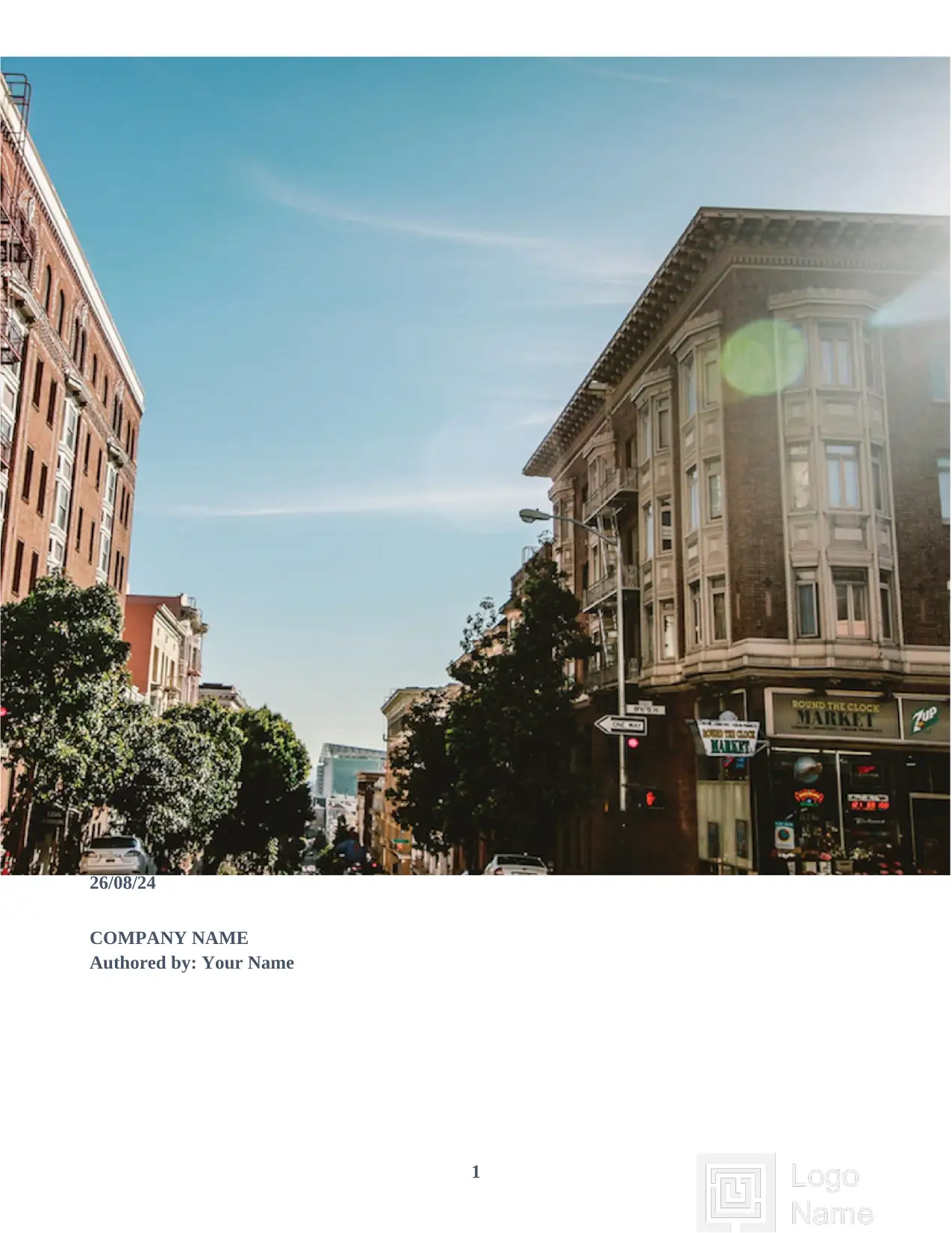
26/08/24
COMPANY NAME
Authored by: Your Name
1
COMPANY NAME
Authored by: Your Name
1
Paraphrase This Document
Need a fresh take? Get an instant paraphrase of this document with our AI Paraphraser
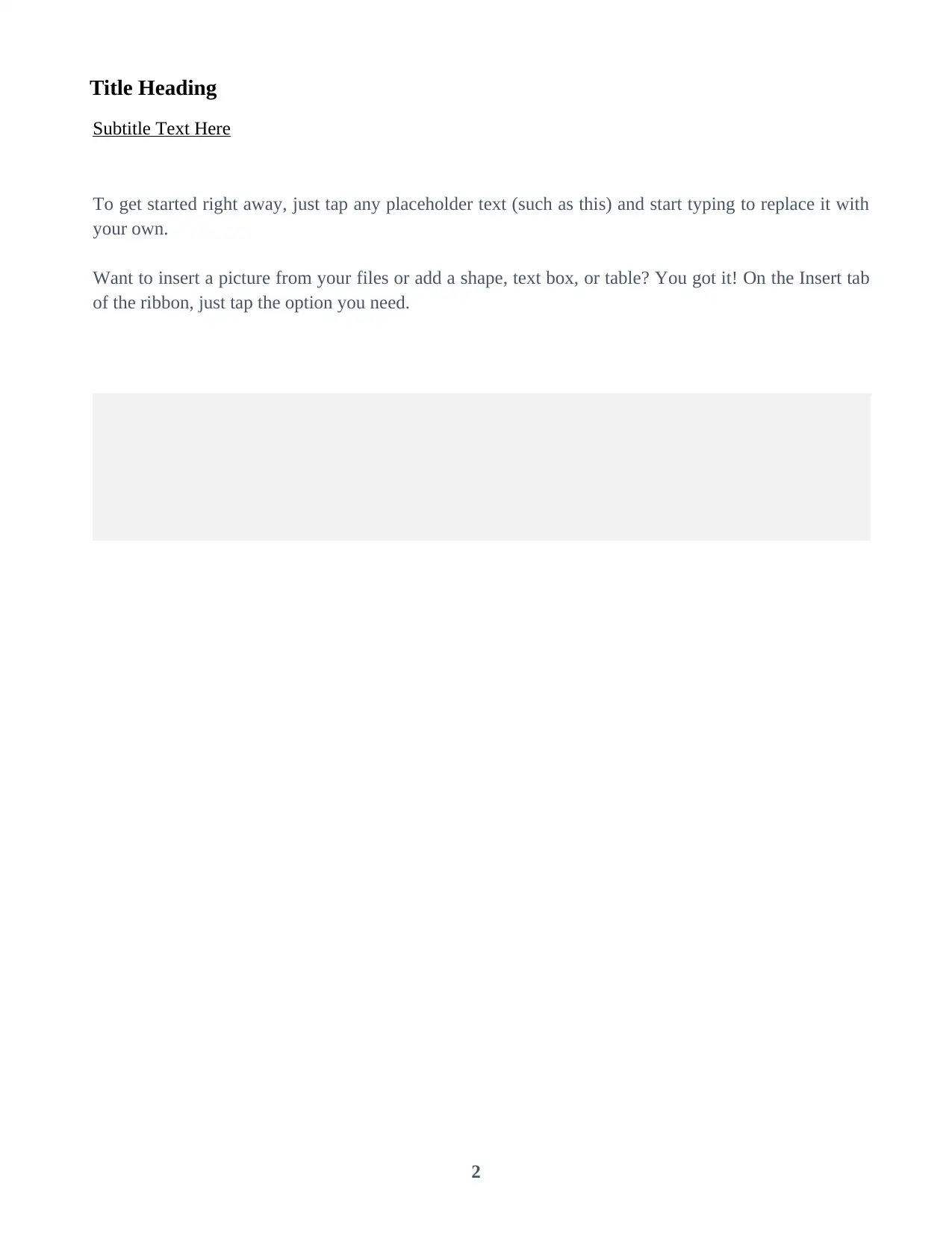
Title Heading
Subtitle Text Here
To get started right away, just tap any placeholder text (such as this) and start typing to replace it with
your own.
Want to insert a picture from your files or add a shape, text box, or table? You got it! On the Insert tab
of the ribbon, just tap the option you need.
2
Subtitle Text Here
To get started right away, just tap any placeholder text (such as this) and start typing to replace it with
your own.
Want to insert a picture from your files or add a shape, text box, or table? You got it! On the Insert tab
of the ribbon, just tap the option you need.
2
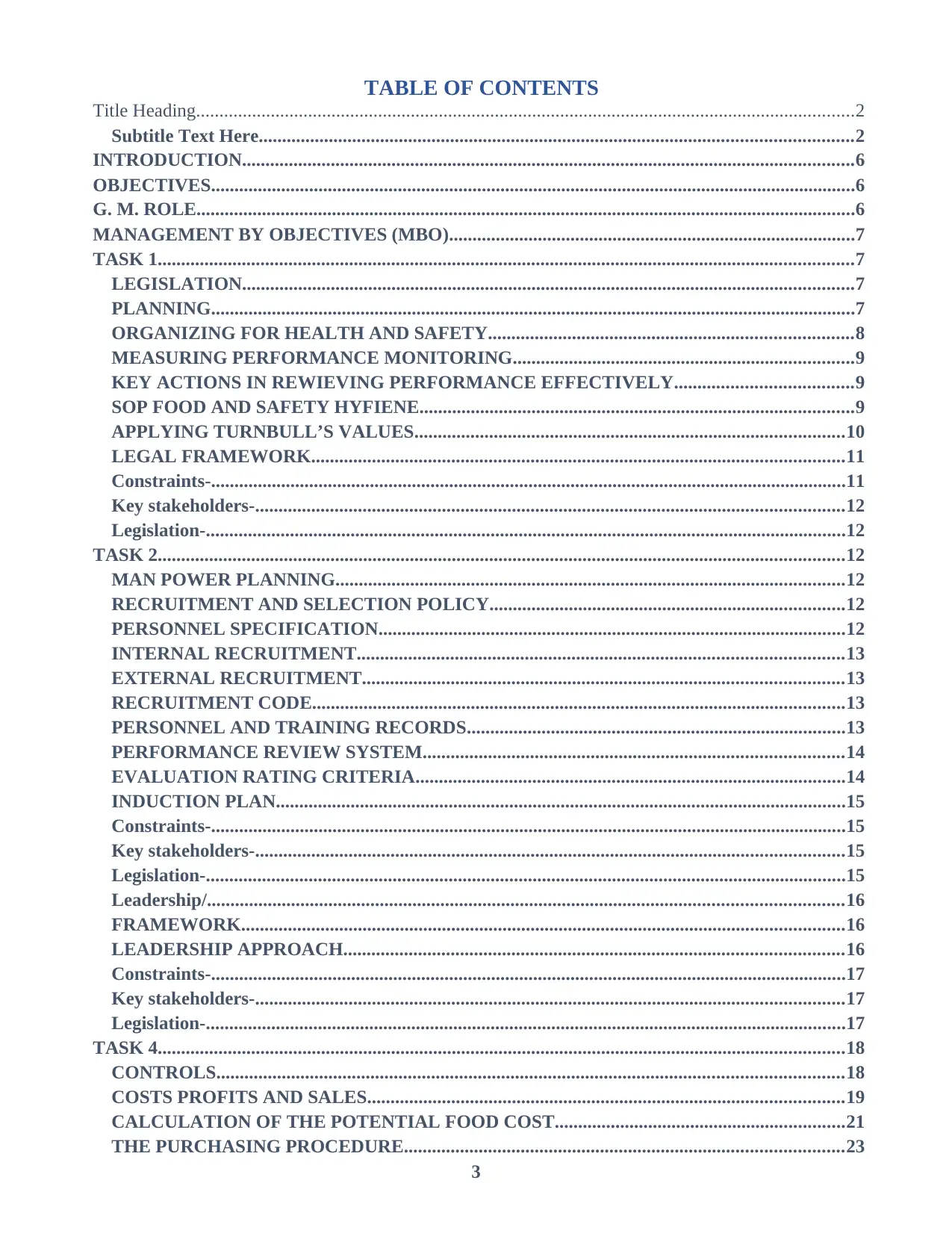
TABLE OF CONTENTS
Title Heading.............................................................................................................................................2
Subtitle Text Here...............................................................................................................................2
INTRODUCTION...................................................................................................................................6
OBJECTIVES..........................................................................................................................................6
G. M. ROLE.............................................................................................................................................6
MANAGEMENT BY OBJECTIVES (MBO).......................................................................................7
TASK 1.....................................................................................................................................................7
LEGISLATION...................................................................................................................................7
PLANNING..........................................................................................................................................7
ORGANIZING FOR HEALTH AND SAFETY..............................................................................8
MEASURING PERFORMANCE MONITORING.........................................................................9
KEY ACTIONS IN REWIEVING PERFORMANCE EFFECTIVELY......................................9
SOP FOOD AND SAFETY HYFIENE.............................................................................................9
APPLYING TURNBULL’S VALUES............................................................................................10
LEGAL FRAMEWORK..................................................................................................................11
Constraints-........................................................................................................................................11
Key stakeholders-..............................................................................................................................12
Legislation-.........................................................................................................................................12
TASK 2...................................................................................................................................................12
MAN POWER PLANNING.............................................................................................................12
RECRUITMENT AND SELECTION POLICY............................................................................12
PERSONNEL SPECIFICATION....................................................................................................12
INTERNAL RECRUITMENT........................................................................................................13
EXTERNAL RECRUITMENT.......................................................................................................13
RECRUITMENT CODE..................................................................................................................13
PERSONNEL AND TRAINING RECORDS.................................................................................13
PERFORMANCE REVIEW SYSTEM..........................................................................................14
EVALUATION RATING CRITERIA............................................................................................14
INDUCTION PLAN..........................................................................................................................15
Constraints-........................................................................................................................................15
Key stakeholders-..............................................................................................................................15
Legislation-.........................................................................................................................................15
Leadership/........................................................................................................................................16
FRAMEWORK.................................................................................................................................16
LEADERSHIP APPROACH...........................................................................................................16
Constraints-........................................................................................................................................17
Key stakeholders-..............................................................................................................................17
Legislation-.........................................................................................................................................17
TASK 4...................................................................................................................................................18
CONTROLS......................................................................................................................................18
COSTS PROFITS AND SALES......................................................................................................19
CALCULATION OF THE POTENTIAL FOOD COST..............................................................21
THE PURCHASING PROCEDURE..............................................................................................23
3
Title Heading.............................................................................................................................................2
Subtitle Text Here...............................................................................................................................2
INTRODUCTION...................................................................................................................................6
OBJECTIVES..........................................................................................................................................6
G. M. ROLE.............................................................................................................................................6
MANAGEMENT BY OBJECTIVES (MBO).......................................................................................7
TASK 1.....................................................................................................................................................7
LEGISLATION...................................................................................................................................7
PLANNING..........................................................................................................................................7
ORGANIZING FOR HEALTH AND SAFETY..............................................................................8
MEASURING PERFORMANCE MONITORING.........................................................................9
KEY ACTIONS IN REWIEVING PERFORMANCE EFFECTIVELY......................................9
SOP FOOD AND SAFETY HYFIENE.............................................................................................9
APPLYING TURNBULL’S VALUES............................................................................................10
LEGAL FRAMEWORK..................................................................................................................11
Constraints-........................................................................................................................................11
Key stakeholders-..............................................................................................................................12
Legislation-.........................................................................................................................................12
TASK 2...................................................................................................................................................12
MAN POWER PLANNING.............................................................................................................12
RECRUITMENT AND SELECTION POLICY............................................................................12
PERSONNEL SPECIFICATION....................................................................................................12
INTERNAL RECRUITMENT........................................................................................................13
EXTERNAL RECRUITMENT.......................................................................................................13
RECRUITMENT CODE..................................................................................................................13
PERSONNEL AND TRAINING RECORDS.................................................................................13
PERFORMANCE REVIEW SYSTEM..........................................................................................14
EVALUATION RATING CRITERIA............................................................................................14
INDUCTION PLAN..........................................................................................................................15
Constraints-........................................................................................................................................15
Key stakeholders-..............................................................................................................................15
Legislation-.........................................................................................................................................15
Leadership/........................................................................................................................................16
FRAMEWORK.................................................................................................................................16
LEADERSHIP APPROACH...........................................................................................................16
Constraints-........................................................................................................................................17
Key stakeholders-..............................................................................................................................17
Legislation-.........................................................................................................................................17
TASK 4...................................................................................................................................................18
CONTROLS......................................................................................................................................18
COSTS PROFITS AND SALES......................................................................................................19
CALCULATION OF THE POTENTIAL FOOD COST..............................................................21
THE PURCHASING PROCEDURE..............................................................................................23
3
⊘ This is a preview!⊘
Do you want full access?
Subscribe today to unlock all pages.

Trusted by 1+ million students worldwide
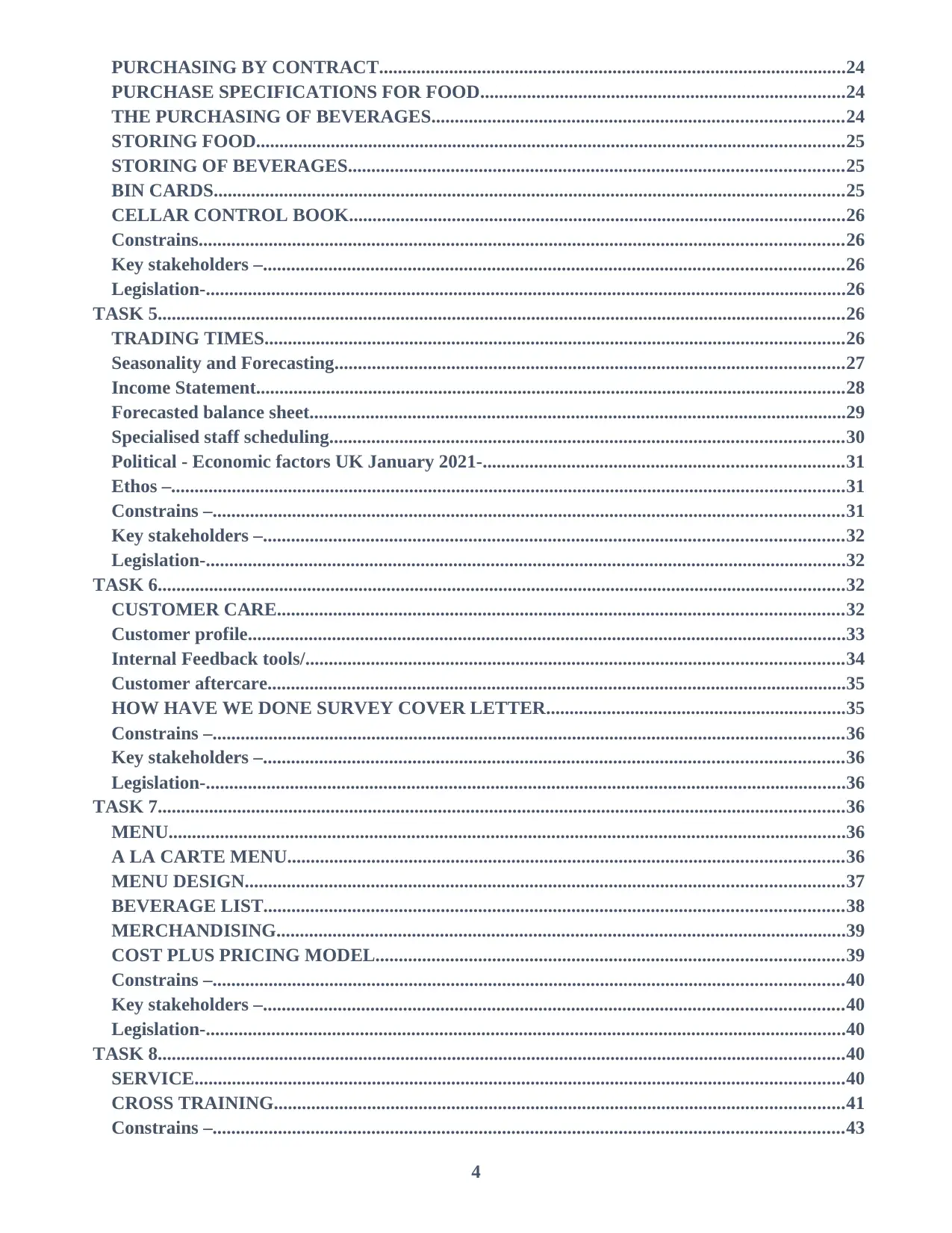
PURCHASING BY CONTRACT....................................................................................................24
PURCHASE SPECIFICATIONS FOR FOOD..............................................................................24
THE PURCHASING OF BEVERAGES........................................................................................24
STORING FOOD..............................................................................................................................25
STORING OF BEVERAGES..........................................................................................................25
BIN CARDS.......................................................................................................................................25
CELLAR CONTROL BOOK..........................................................................................................26
Constrains..........................................................................................................................................26
Key stakeholders –............................................................................................................................26
Legislation-.........................................................................................................................................26
TASK 5...................................................................................................................................................26
TRADING TIMES............................................................................................................................26
Seasonality and Forecasting.............................................................................................................27
Income Statement..............................................................................................................................28
Forecasted balance sheet...................................................................................................................29
Specialised staff scheduling..............................................................................................................30
Political - Economic factors UK January 2021-.............................................................................31
Ethos –................................................................................................................................................31
Constrains –.......................................................................................................................................31
Key stakeholders –............................................................................................................................32
Legislation-.........................................................................................................................................32
TASK 6...................................................................................................................................................32
CUSTOMER CARE.........................................................................................................................32
Customer profile................................................................................................................................33
Internal Feedback tools/...................................................................................................................34
Customer aftercare............................................................................................................................35
HOW HAVE WE DONE SURVEY COVER LETTER................................................................35
Constrains –.......................................................................................................................................36
Key stakeholders –............................................................................................................................36
Legislation-.........................................................................................................................................36
TASK 7...................................................................................................................................................36
MENU.................................................................................................................................................36
A LA CARTE MENU.......................................................................................................................36
MENU DESIGN................................................................................................................................37
BEVERAGE LIST............................................................................................................................38
MERCHANDISING..........................................................................................................................39
COST PLUS PRICING MODEL....................................................................................................39
Constrains –.......................................................................................................................................40
Key stakeholders –............................................................................................................................40
Legislation-.........................................................................................................................................40
TASK 8...................................................................................................................................................40
SERVICE...........................................................................................................................................40
CROSS TRAINING..........................................................................................................................41
Constrains –.......................................................................................................................................43
4
PURCHASE SPECIFICATIONS FOR FOOD..............................................................................24
THE PURCHASING OF BEVERAGES........................................................................................24
STORING FOOD..............................................................................................................................25
STORING OF BEVERAGES..........................................................................................................25
BIN CARDS.......................................................................................................................................25
CELLAR CONTROL BOOK..........................................................................................................26
Constrains..........................................................................................................................................26
Key stakeholders –............................................................................................................................26
Legislation-.........................................................................................................................................26
TASK 5...................................................................................................................................................26
TRADING TIMES............................................................................................................................26
Seasonality and Forecasting.............................................................................................................27
Income Statement..............................................................................................................................28
Forecasted balance sheet...................................................................................................................29
Specialised staff scheduling..............................................................................................................30
Political - Economic factors UK January 2021-.............................................................................31
Ethos –................................................................................................................................................31
Constrains –.......................................................................................................................................31
Key stakeholders –............................................................................................................................32
Legislation-.........................................................................................................................................32
TASK 6...................................................................................................................................................32
CUSTOMER CARE.........................................................................................................................32
Customer profile................................................................................................................................33
Internal Feedback tools/...................................................................................................................34
Customer aftercare............................................................................................................................35
HOW HAVE WE DONE SURVEY COVER LETTER................................................................35
Constrains –.......................................................................................................................................36
Key stakeholders –............................................................................................................................36
Legislation-.........................................................................................................................................36
TASK 7...................................................................................................................................................36
MENU.................................................................................................................................................36
A LA CARTE MENU.......................................................................................................................36
MENU DESIGN................................................................................................................................37
BEVERAGE LIST............................................................................................................................38
MERCHANDISING..........................................................................................................................39
COST PLUS PRICING MODEL....................................................................................................39
Constrains –.......................................................................................................................................40
Key stakeholders –............................................................................................................................40
Legislation-.........................................................................................................................................40
TASK 8...................................................................................................................................................40
SERVICE...........................................................................................................................................40
CROSS TRAINING..........................................................................................................................41
Constrains –.......................................................................................................................................43
4
Paraphrase This Document
Need a fresh take? Get an instant paraphrase of this document with our AI Paraphraser
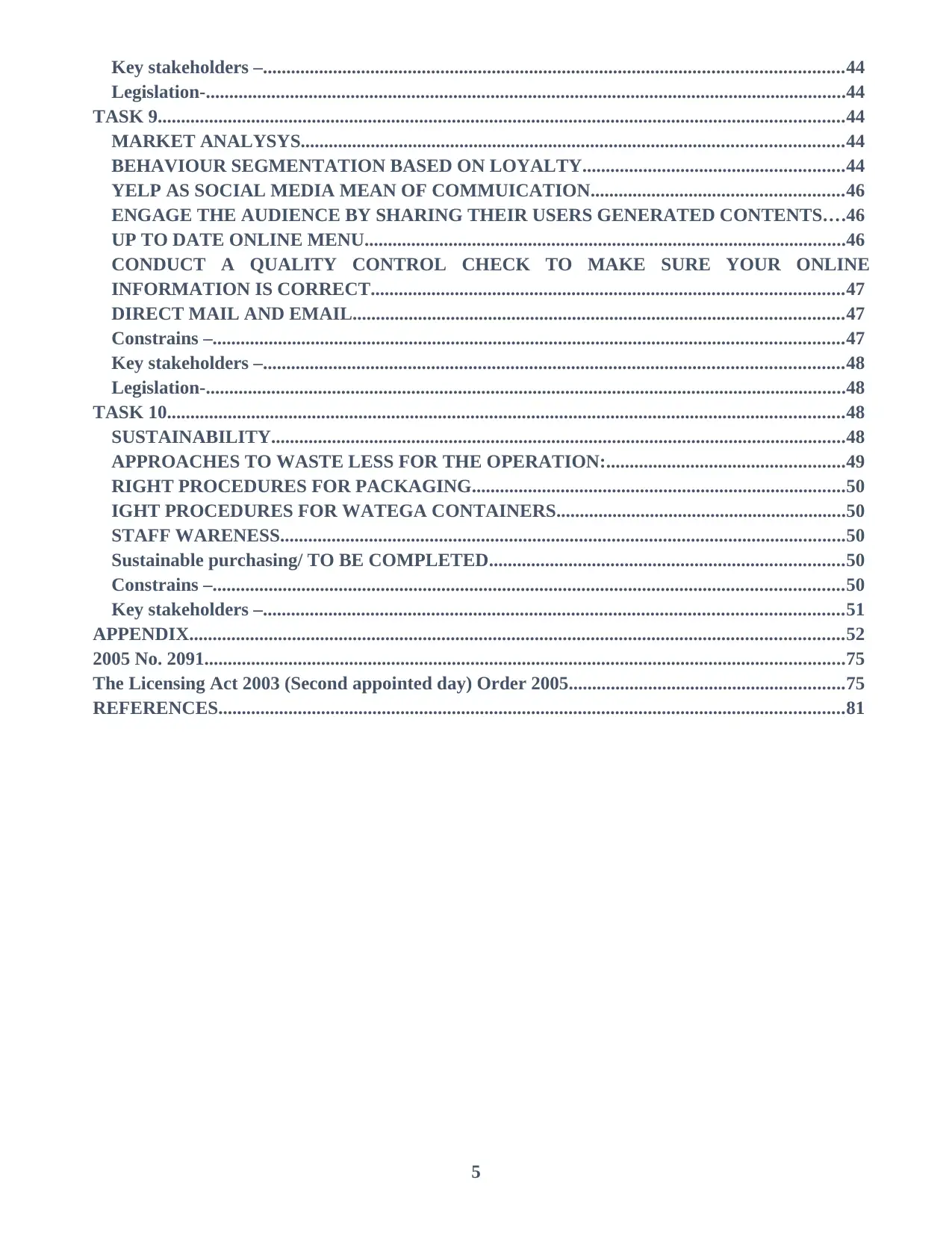
Key stakeholders –............................................................................................................................44
Legislation-.........................................................................................................................................44
TASK 9...................................................................................................................................................44
MARKET ANALYSYS....................................................................................................................44
BEHAVIOUR SEGMENTATION BASED ON LOYALTY........................................................44
YELP AS SOCIAL MEDIA MEAN OF COMMUICATION......................................................46
ENGAGE THE AUDIENCE BY SHARING THEIR USERS GENERATED CONTENTS....46
UP TO DATE ONLINE MENU.......................................................................................................46
CONDUCT A QUALITY CONTROL CHECK TO MAKE SURE YOUR ONLINE
INFORMATION IS CORRECT.....................................................................................................47
DIRECT MAIL AND EMAIL.........................................................................................................47
Constrains –.......................................................................................................................................47
Key stakeholders –............................................................................................................................48
Legislation-.........................................................................................................................................48
TASK 10.................................................................................................................................................48
SUSTAINABILITY...........................................................................................................................48
APPROACHES TO WASTE LESS FOR THE OPERATION:...................................................49
RIGHT PROCEDURES FOR PACKAGING................................................................................50
IGHT PROCEDURES FOR WATEGA CONTAINERS..............................................................50
STAFF WARENESS.........................................................................................................................50
Sustainable purchasing/ TO BE COMPLETED............................................................................50
Constrains –.......................................................................................................................................50
Key stakeholders –............................................................................................................................51
APPENDIX............................................................................................................................................52
2005 No. 2091.........................................................................................................................................75
The Licensing Act 2003 (Second appointed day) Order 2005...........................................................75
REFERENCES......................................................................................................................................81
5
Legislation-.........................................................................................................................................44
TASK 9...................................................................................................................................................44
MARKET ANALYSYS....................................................................................................................44
BEHAVIOUR SEGMENTATION BASED ON LOYALTY........................................................44
YELP AS SOCIAL MEDIA MEAN OF COMMUICATION......................................................46
ENGAGE THE AUDIENCE BY SHARING THEIR USERS GENERATED CONTENTS....46
UP TO DATE ONLINE MENU.......................................................................................................46
CONDUCT A QUALITY CONTROL CHECK TO MAKE SURE YOUR ONLINE
INFORMATION IS CORRECT.....................................................................................................47
DIRECT MAIL AND EMAIL.........................................................................................................47
Constrains –.......................................................................................................................................47
Key stakeholders –............................................................................................................................48
Legislation-.........................................................................................................................................48
TASK 10.................................................................................................................................................48
SUSTAINABILITY...........................................................................................................................48
APPROACHES TO WASTE LESS FOR THE OPERATION:...................................................49
RIGHT PROCEDURES FOR PACKAGING................................................................................50
IGHT PROCEDURES FOR WATEGA CONTAINERS..............................................................50
STAFF WARENESS.........................................................................................................................50
Sustainable purchasing/ TO BE COMPLETED............................................................................50
Constrains –.......................................................................................................................................50
Key stakeholders –............................................................................................................................51
APPENDIX............................................................................................................................................52
2005 No. 2091.........................................................................................................................................75
The Licensing Act 2003 (Second appointed day) Order 2005...........................................................75
REFERENCES......................................................................................................................................81
5
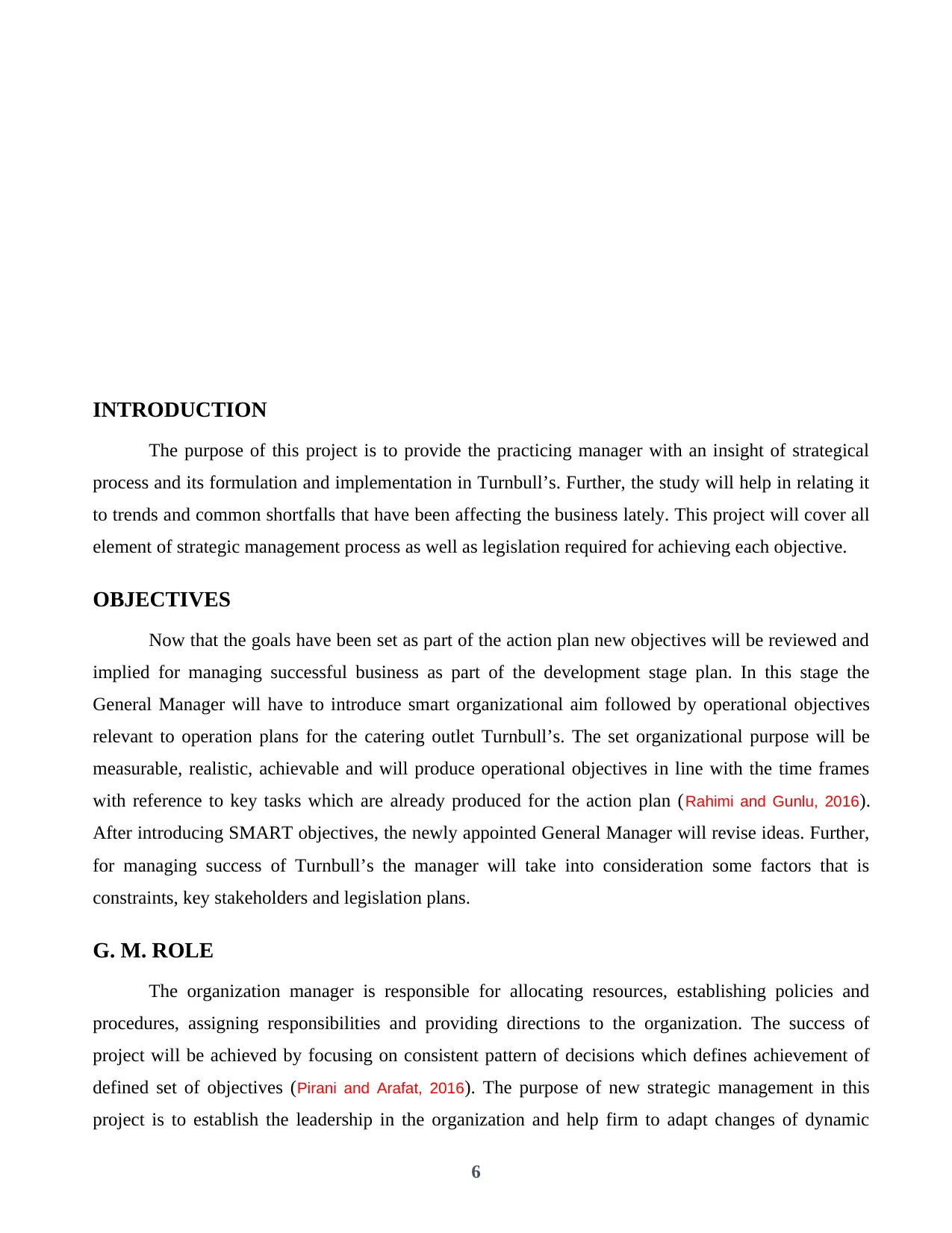
INTRODUCTION
The purpose of this project is to provide the practicing manager with an insight of strategical
process and its formulation and implementation in Turnbull’s. Further, the study will help in relating it
to trends and common shortfalls that have been affecting the business lately. This project will cover all
element of strategic management process as well as legislation required for achieving each objective.
OBJECTIVES
Now that the goals have been set as part of the action plan new objectives will be reviewed and
implied for managing successful business as part of the development stage plan. In this stage the
General Manager will have to introduce smart organizational aim followed by operational objectives
relevant to operation plans for the catering outlet Turnbull’s. The set organizational purpose will be
measurable, realistic, achievable and will produce operational objectives in line with the time frames
with reference to key tasks which are already produced for the action plan (Rahimi and Gunlu, 2016).
After introducing SMART objectives, the newly appointed General Manager will revise ideas. Further,
for managing success of Turnbull’s the manager will take into consideration some factors that is
constraints, key stakeholders and legislation plans.
G. M. ROLE
The organization manager is responsible for allocating resources, establishing policies and
procedures, assigning responsibilities and providing directions to the organization. The success of
project will be achieved by focusing on consistent pattern of decisions which defines achievement of
defined set of objectives (Pirani and Arafat, 2016). The purpose of new strategic management in this
project is to establish the leadership in the organization and help firm to adapt changes of dynamic
6
The purpose of this project is to provide the practicing manager with an insight of strategical
process and its formulation and implementation in Turnbull’s. Further, the study will help in relating it
to trends and common shortfalls that have been affecting the business lately. This project will cover all
element of strategic management process as well as legislation required for achieving each objective.
OBJECTIVES
Now that the goals have been set as part of the action plan new objectives will be reviewed and
implied for managing successful business as part of the development stage plan. In this stage the
General Manager will have to introduce smart organizational aim followed by operational objectives
relevant to operation plans for the catering outlet Turnbull’s. The set organizational purpose will be
measurable, realistic, achievable and will produce operational objectives in line with the time frames
with reference to key tasks which are already produced for the action plan (Rahimi and Gunlu, 2016).
After introducing SMART objectives, the newly appointed General Manager will revise ideas. Further,
for managing success of Turnbull’s the manager will take into consideration some factors that is
constraints, key stakeholders and legislation plans.
G. M. ROLE
The organization manager is responsible for allocating resources, establishing policies and
procedures, assigning responsibilities and providing directions to the organization. The success of
project will be achieved by focusing on consistent pattern of decisions which defines achievement of
defined set of objectives (Pirani and Arafat, 2016). The purpose of new strategic management in this
project is to establish the leadership in the organization and help firm to adapt changes of dynamic
6
⊘ This is a preview!⊘
Do you want full access?
Subscribe today to unlock all pages.

Trusted by 1+ million students worldwide
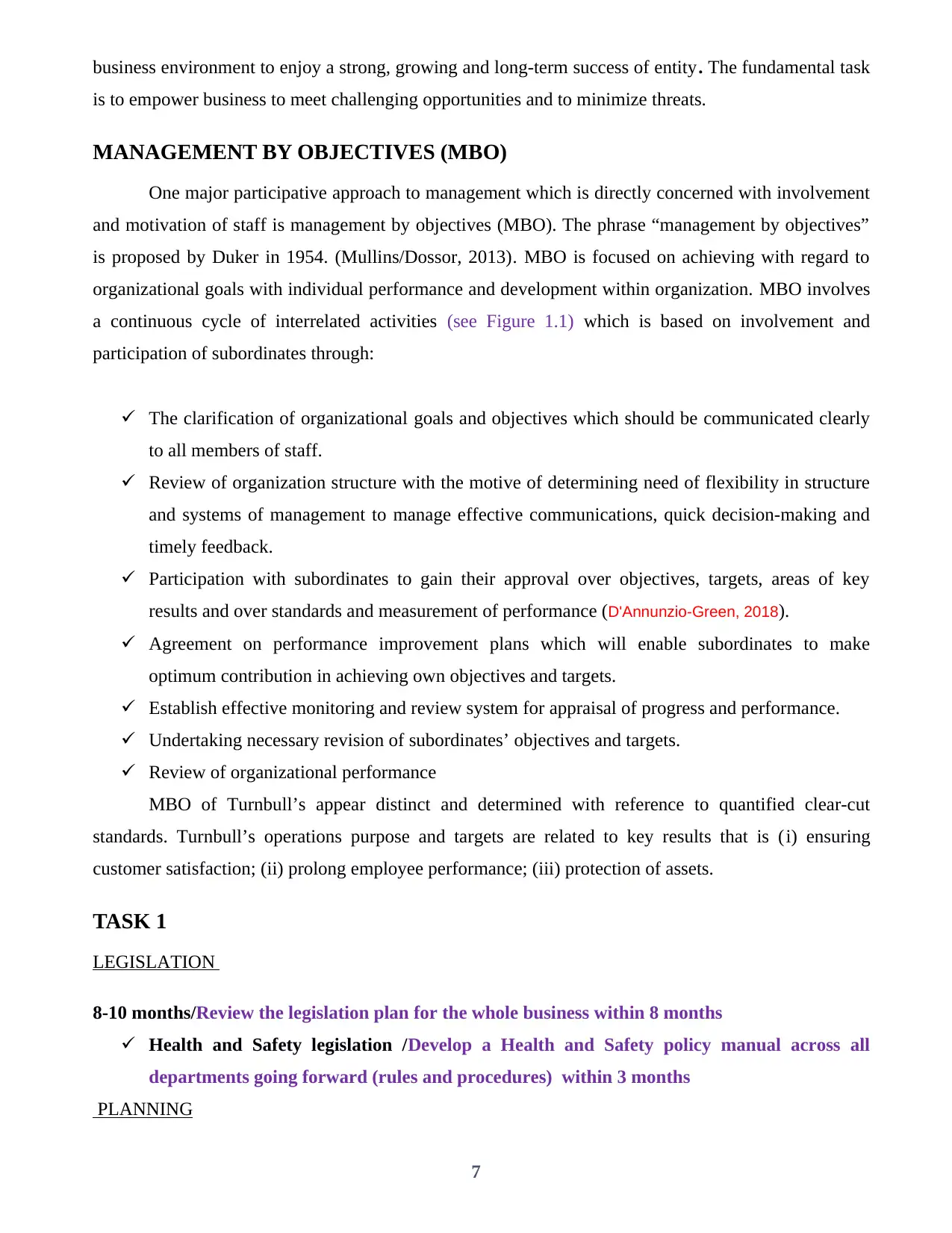
business environment to enjoy a strong, growing and long-term success of entity. The fundamental task
is to empower business to meet challenging opportunities and to minimize threats.
MANAGEMENT BY OBJECTIVES (MBO)
One major participative approach to management which is directly concerned with involvement
and motivation of staff is management by objectives (MBO). The phrase “management by objectives”
is proposed by Duker in 1954. (Mullins/Dossor, 2013). MBO is focused on achieving with regard to
organizational goals with individual performance and development within organization. MBO involves
a continuous cycle of interrelated activities (see Figure 1.1) which is based on involvement and
participation of subordinates through:
The clarification of organizational goals and objectives which should be communicated clearly
to all members of staff.
Review of organization structure with the motive of determining need of flexibility in structure
and systems of management to manage effective communications, quick decision-making and
timely feedback.
Participation with subordinates to gain their approval over objectives, targets, areas of key
results and over standards and measurement of performance (D'Annunzio-Green, 2018).
Agreement on performance improvement plans which will enable subordinates to make
optimum contribution in achieving own objectives and targets.
Establish effective monitoring and review system for appraisal of progress and performance.
Undertaking necessary revision of subordinates’ objectives and targets.
Review of organizational performance
MBO of Turnbull’s appear distinct and determined with reference to quantified clear-cut
standards. Turnbull’s operations purpose and targets are related to key results that is (i) ensuring
customer satisfaction; (ii) prolong employee performance; (iii) protection of assets.
TASK 1
LEGISLATION
8-10 months/Review the legislation plan for the whole business within 8 months
Health and Safety legislation /Develop a Health and Safety policy manual across all
departments going forward (rules and procedures) within 3 months
PLANNING
7
is to empower business to meet challenging opportunities and to minimize threats.
MANAGEMENT BY OBJECTIVES (MBO)
One major participative approach to management which is directly concerned with involvement
and motivation of staff is management by objectives (MBO). The phrase “management by objectives”
is proposed by Duker in 1954. (Mullins/Dossor, 2013). MBO is focused on achieving with regard to
organizational goals with individual performance and development within organization. MBO involves
a continuous cycle of interrelated activities (see Figure 1.1) which is based on involvement and
participation of subordinates through:
The clarification of organizational goals and objectives which should be communicated clearly
to all members of staff.
Review of organization structure with the motive of determining need of flexibility in structure
and systems of management to manage effective communications, quick decision-making and
timely feedback.
Participation with subordinates to gain their approval over objectives, targets, areas of key
results and over standards and measurement of performance (D'Annunzio-Green, 2018).
Agreement on performance improvement plans which will enable subordinates to make
optimum contribution in achieving own objectives and targets.
Establish effective monitoring and review system for appraisal of progress and performance.
Undertaking necessary revision of subordinates’ objectives and targets.
Review of organizational performance
MBO of Turnbull’s appear distinct and determined with reference to quantified clear-cut
standards. Turnbull’s operations purpose and targets are related to key results that is (i) ensuring
customer satisfaction; (ii) prolong employee performance; (iii) protection of assets.
TASK 1
LEGISLATION
8-10 months/Review the legislation plan for the whole business within 8 months
Health and Safety legislation /Develop a Health and Safety policy manual across all
departments going forward (rules and procedures) within 3 months
PLANNING
7
Paraphrase This Document
Need a fresh take? Get an instant paraphrase of this document with our AI Paraphraser
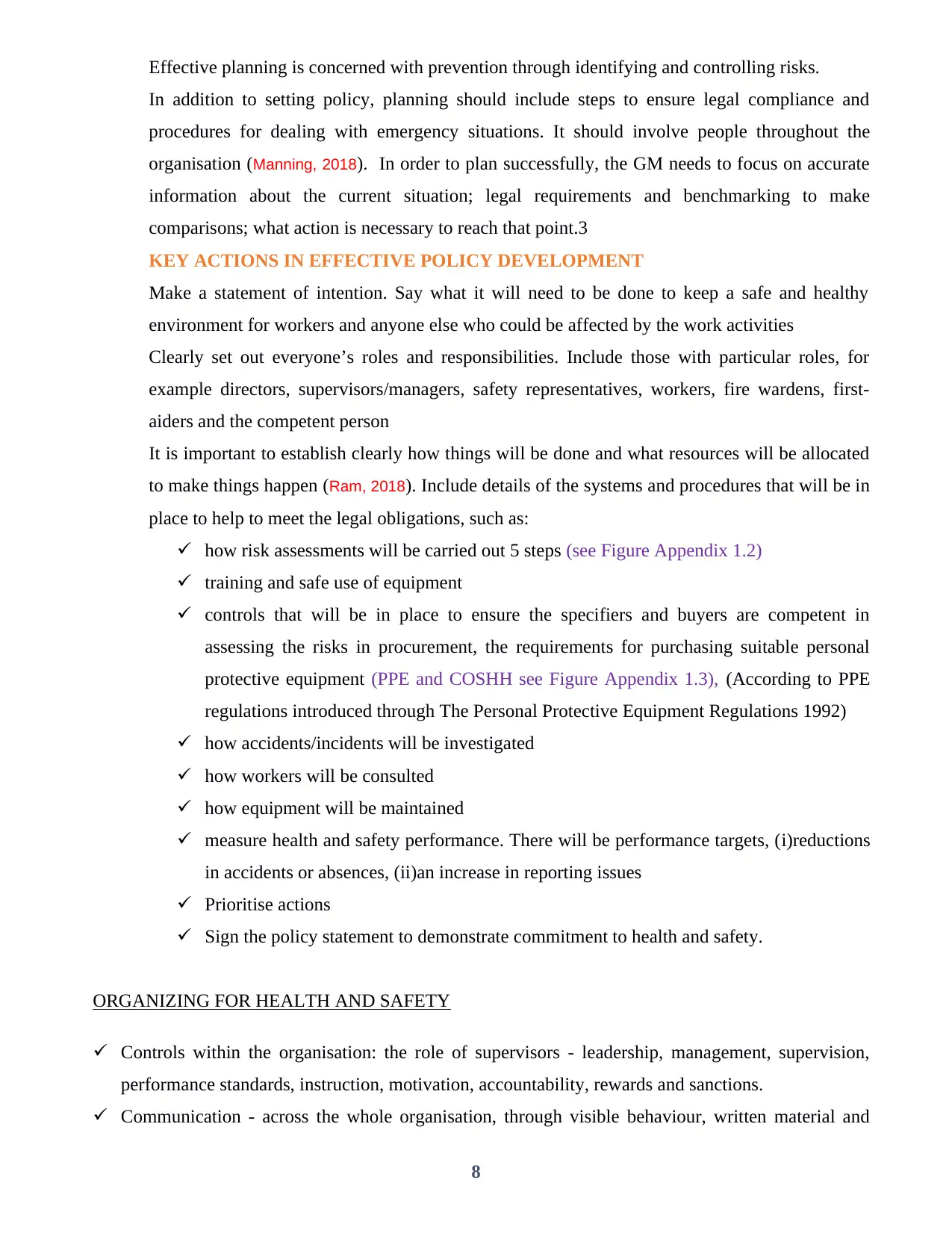
Effective planning is concerned with prevention through identifying and controlling risks.
In addition to setting policy, planning should include steps to ensure legal compliance and
procedures for dealing with emergency situations. It should involve people throughout the
organisation (Manning, 2018). In order to plan successfully, the GM needs to focus on accurate
information about the current situation; legal requirements and benchmarking to make
comparisons; what action is necessary to reach that point.3
KEY ACTIONS IN EFFECTIVE POLICY DEVELOPMENT
Make a statement of intention. Say what it will need to be done to keep a safe and healthy
environment for workers and anyone else who could be affected by the work activities
Clearly set out everyone’s roles and responsibilities. Include those with particular roles, for
example directors, supervisors/managers, safety representatives, workers, fire wardens, first-
aiders and the competent person
It is important to establish clearly how things will be done and what resources will be allocated
to make things happen (Ram, 2018). Include details of the systems and procedures that will be in
place to help to meet the legal obligations, such as:
how risk assessments will be carried out 5 steps (see Figure Appendix 1.2)
training and safe use of equipment
controls that will be in place to ensure the specifiers and buyers are competent in
assessing the risks in procurement, the requirements for purchasing suitable personal
protective equipment (PPE and COSHH see Figure Appendix 1.3), (According to PPE
regulations introduced through The Personal Protective Equipment Regulations 1992)
how accidents/incidents will be investigated
how workers will be consulted
how equipment will be maintained
measure health and safety performance. There will be performance targets, (i)reductions
in accidents or absences, (ii)an increase in reporting issues
Prioritise actions
Sign the policy statement to demonstrate commitment to health and safety.
ORGANIZING FOR HEALTH AND SAFETY
Controls within the organisation: the role of supervisors - leadership, management, supervision,
performance standards, instruction, motivation, accountability, rewards and sanctions.
Communication - across the whole organisation, through visible behaviour, written material and
8
In addition to setting policy, planning should include steps to ensure legal compliance and
procedures for dealing with emergency situations. It should involve people throughout the
organisation (Manning, 2018). In order to plan successfully, the GM needs to focus on accurate
information about the current situation; legal requirements and benchmarking to make
comparisons; what action is necessary to reach that point.3
KEY ACTIONS IN EFFECTIVE POLICY DEVELOPMENT
Make a statement of intention. Say what it will need to be done to keep a safe and healthy
environment for workers and anyone else who could be affected by the work activities
Clearly set out everyone’s roles and responsibilities. Include those with particular roles, for
example directors, supervisors/managers, safety representatives, workers, fire wardens, first-
aiders and the competent person
It is important to establish clearly how things will be done and what resources will be allocated
to make things happen (Ram, 2018). Include details of the systems and procedures that will be in
place to help to meet the legal obligations, such as:
how risk assessments will be carried out 5 steps (see Figure Appendix 1.2)
training and safe use of equipment
controls that will be in place to ensure the specifiers and buyers are competent in
assessing the risks in procurement, the requirements for purchasing suitable personal
protective equipment (PPE and COSHH see Figure Appendix 1.3), (According to PPE
regulations introduced through The Personal Protective Equipment Regulations 1992)
how accidents/incidents will be investigated
how workers will be consulted
how equipment will be maintained
measure health and safety performance. There will be performance targets, (i)reductions
in accidents or absences, (ii)an increase in reporting issues
Prioritise actions
Sign the policy statement to demonstrate commitment to health and safety.
ORGANIZING FOR HEALTH AND SAFETY
Controls within the organisation: the role of supervisors - leadership, management, supervision,
performance standards, instruction, motivation, accountability, rewards and sanctions.
Communication - across the whole organisation, through visible behaviour, written material and
8
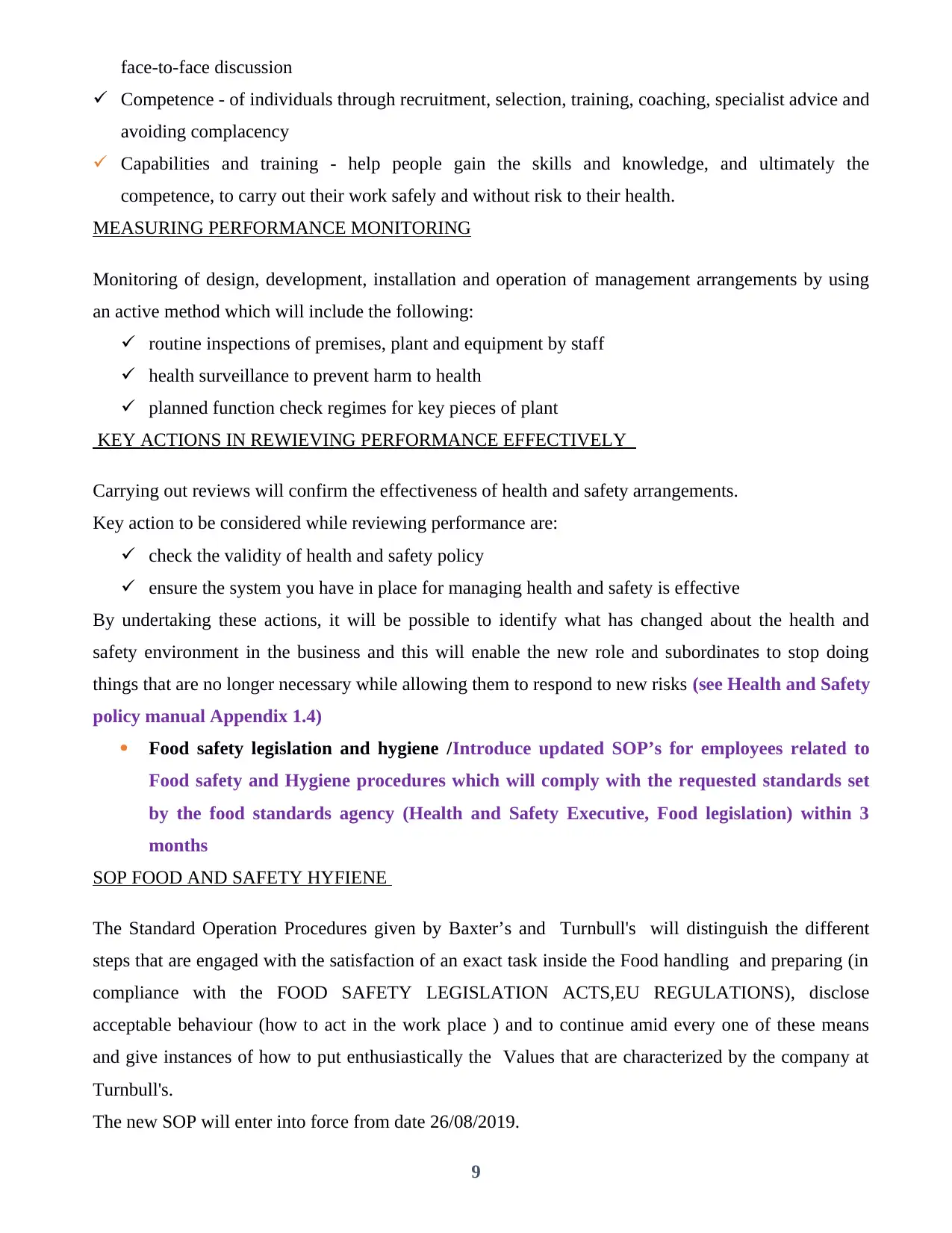
face-to-face discussion
Competence - of individuals through recruitment, selection, training, coaching, specialist advice and
avoiding complacency
Capabilities and training - help people gain the skills and knowledge, and ultimately the
competence, to carry out their work safely and without risk to their health.
MEASURING PERFORMANCE MONITORING
Monitoring of design, development, installation and operation of management arrangements by using
an active method which will include the following:
routine inspections of premises, plant and equipment by staff
health surveillance to prevent harm to health
planned function check regimes for key pieces of plant
KEY ACTIONS IN REWIEVING PERFORMANCE EFFECTIVELY
Carrying out reviews will confirm the effectiveness of health and safety arrangements.
Key action to be considered while reviewing performance are:
check the validity of health and safety policy
ensure the system you have in place for managing health and safety is effective
By undertaking these actions, it will be possible to identify what has changed about the health and
safety environment in the business and this will enable the new role and subordinates to stop doing
things that are no longer necessary while allowing them to respond to new risks (see Health and Safety
policy manual Appendix 1.4)
Food safety legislation and hygiene /Introduce updated SOP’s for employees related to
Food safety and Hygiene procedures which will comply with the requested standards set
by the food standards agency (Health and Safety Executive, Food legislation) within 3
months
SOP FOOD AND SAFETY HYFIENE
The Standard Operation Procedures given by Baxter’s and Turnbull's will distinguish the different
steps that are engaged with the satisfaction of an exact task inside the Food handling and preparing (in
compliance with the FOOD SAFETY LEGISLATION ACTS,EU REGULATIONS), disclose
acceptable behaviour (how to act in the work place ) and to continue amid every one of these means
and give instances of how to put enthusiastically the Values that are characterized by the company at
Turnbull's.
The new SOP will enter into force from date 26/08/2019.
9
Competence - of individuals through recruitment, selection, training, coaching, specialist advice and
avoiding complacency
Capabilities and training - help people gain the skills and knowledge, and ultimately the
competence, to carry out their work safely and without risk to their health.
MEASURING PERFORMANCE MONITORING
Monitoring of design, development, installation and operation of management arrangements by using
an active method which will include the following:
routine inspections of premises, plant and equipment by staff
health surveillance to prevent harm to health
planned function check regimes for key pieces of plant
KEY ACTIONS IN REWIEVING PERFORMANCE EFFECTIVELY
Carrying out reviews will confirm the effectiveness of health and safety arrangements.
Key action to be considered while reviewing performance are:
check the validity of health and safety policy
ensure the system you have in place for managing health and safety is effective
By undertaking these actions, it will be possible to identify what has changed about the health and
safety environment in the business and this will enable the new role and subordinates to stop doing
things that are no longer necessary while allowing them to respond to new risks (see Health and Safety
policy manual Appendix 1.4)
Food safety legislation and hygiene /Introduce updated SOP’s for employees related to
Food safety and Hygiene procedures which will comply with the requested standards set
by the food standards agency (Health and Safety Executive, Food legislation) within 3
months
SOP FOOD AND SAFETY HYFIENE
The Standard Operation Procedures given by Baxter’s and Turnbull's will distinguish the different
steps that are engaged with the satisfaction of an exact task inside the Food handling and preparing (in
compliance with the FOOD SAFETY LEGISLATION ACTS,EU REGULATIONS), disclose
acceptable behaviour (how to act in the work place ) and to continue amid every one of these means
and give instances of how to put enthusiastically the Values that are characterized by the company at
Turnbull's.
The new SOP will enter into force from date 26/08/2019.
9
⊘ This is a preview!⊘
Do you want full access?
Subscribe today to unlock all pages.

Trusted by 1+ million students worldwide
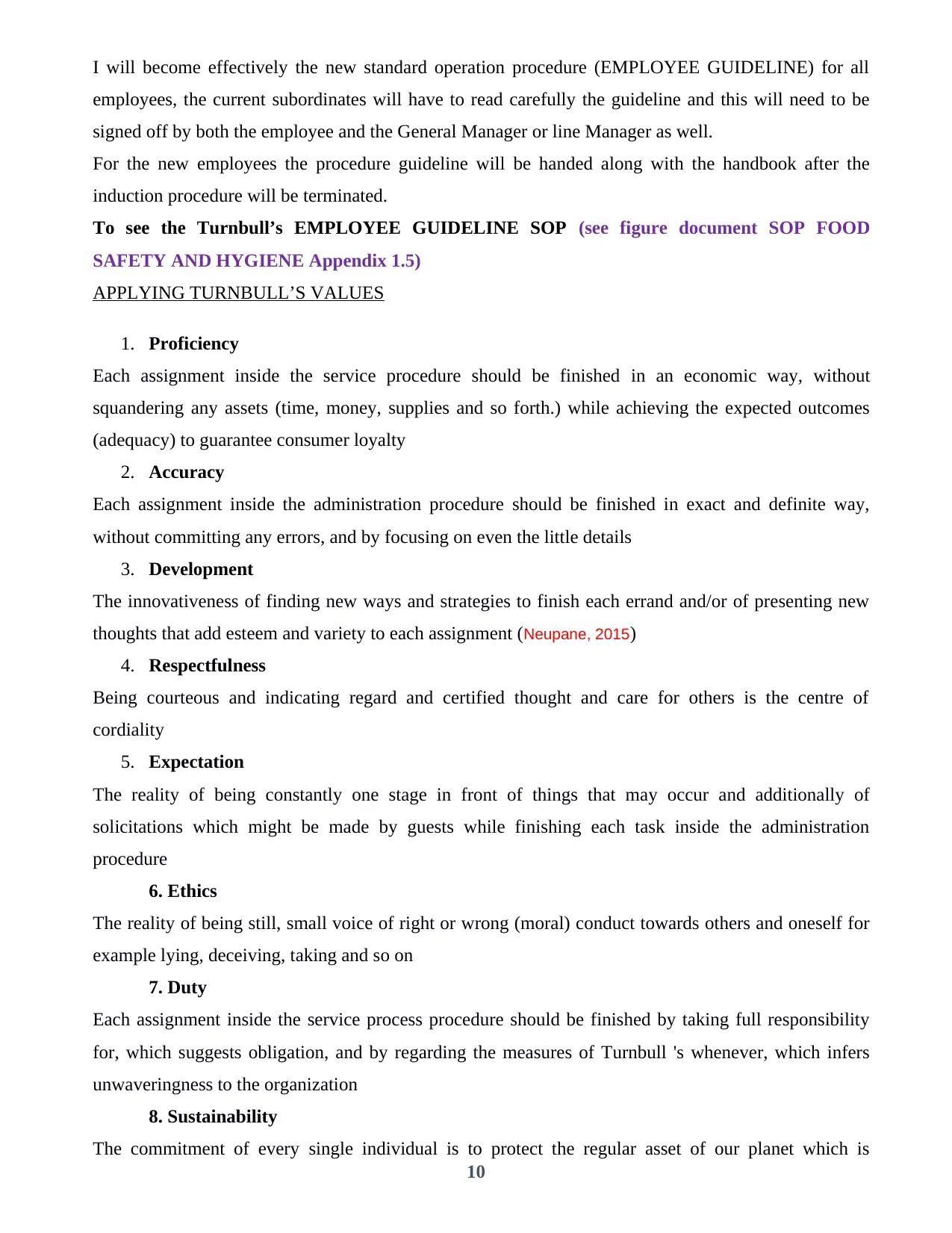
I will become effectively the new standard operation procedure (EMPLOYEE GUIDELINE) for all
employees, the current subordinates will have to read carefully the guideline and this will need to be
signed off by both the employee and the General Manager or line Manager as well.
For the new employees the procedure guideline will be handed along with the handbook after the
induction procedure will be terminated.
To see the Turnbull’s EMPLOYEE GUIDELINE SOP (see figure document SOP FOOD
SAFETY AND HYGIENE Appendix 1.5)
APPLYING TURNBULL’S VALUES
1. Proficiency
Each assignment inside the service procedure should be finished in an economic way, without
squandering any assets (time, money, supplies and so forth.) while achieving the expected outcomes
(adequacy) to guarantee consumer loyalty
2. Accuracy
Each assignment inside the administration procedure should be finished in exact and definite way,
without committing any errors, and by focusing on even the little details
3. Development
The innovativeness of finding new ways and strategies to finish each errand and/or of presenting new
thoughts that add esteem and variety to each assignment (Neupane, 2015)
4. Respectfulness
Being courteous and indicating regard and certified thought and care for others is the centre of
cordiality
5. Expectation
The reality of being constantly one stage in front of things that may occur and additionally of
solicitations which might be made by guests while finishing each task inside the administration
procedure
6. Ethics
The reality of being still, small voice of right or wrong (moral) conduct towards others and oneself for
example lying, deceiving, taking and so on
7. Duty
Each assignment inside the service process procedure should be finished by taking full responsibility
for, which suggests obligation, and by regarding the measures of Turnbull 's whenever, which infers
unwaveringness to the organization
8. Sustainability
The commitment of every single individual is to protect the regular asset of our planet which is
10
employees, the current subordinates will have to read carefully the guideline and this will need to be
signed off by both the employee and the General Manager or line Manager as well.
For the new employees the procedure guideline will be handed along with the handbook after the
induction procedure will be terminated.
To see the Turnbull’s EMPLOYEE GUIDELINE SOP (see figure document SOP FOOD
SAFETY AND HYGIENE Appendix 1.5)
APPLYING TURNBULL’S VALUES
1. Proficiency
Each assignment inside the service procedure should be finished in an economic way, without
squandering any assets (time, money, supplies and so forth.) while achieving the expected outcomes
(adequacy) to guarantee consumer loyalty
2. Accuracy
Each assignment inside the administration procedure should be finished in exact and definite way,
without committing any errors, and by focusing on even the little details
3. Development
The innovativeness of finding new ways and strategies to finish each errand and/or of presenting new
thoughts that add esteem and variety to each assignment (Neupane, 2015)
4. Respectfulness
Being courteous and indicating regard and certified thought and care for others is the centre of
cordiality
5. Expectation
The reality of being constantly one stage in front of things that may occur and additionally of
solicitations which might be made by guests while finishing each task inside the administration
procedure
6. Ethics
The reality of being still, small voice of right or wrong (moral) conduct towards others and oneself for
example lying, deceiving, taking and so on
7. Duty
Each assignment inside the service process procedure should be finished by taking full responsibility
for, which suggests obligation, and by regarding the measures of Turnbull 's whenever, which infers
unwaveringness to the organization
8. Sustainability
The commitment of every single individual is to protect the regular asset of our planet which is
10
Paraphrase This Document
Need a fresh take? Get an instant paraphrase of this document with our AI Paraphraser
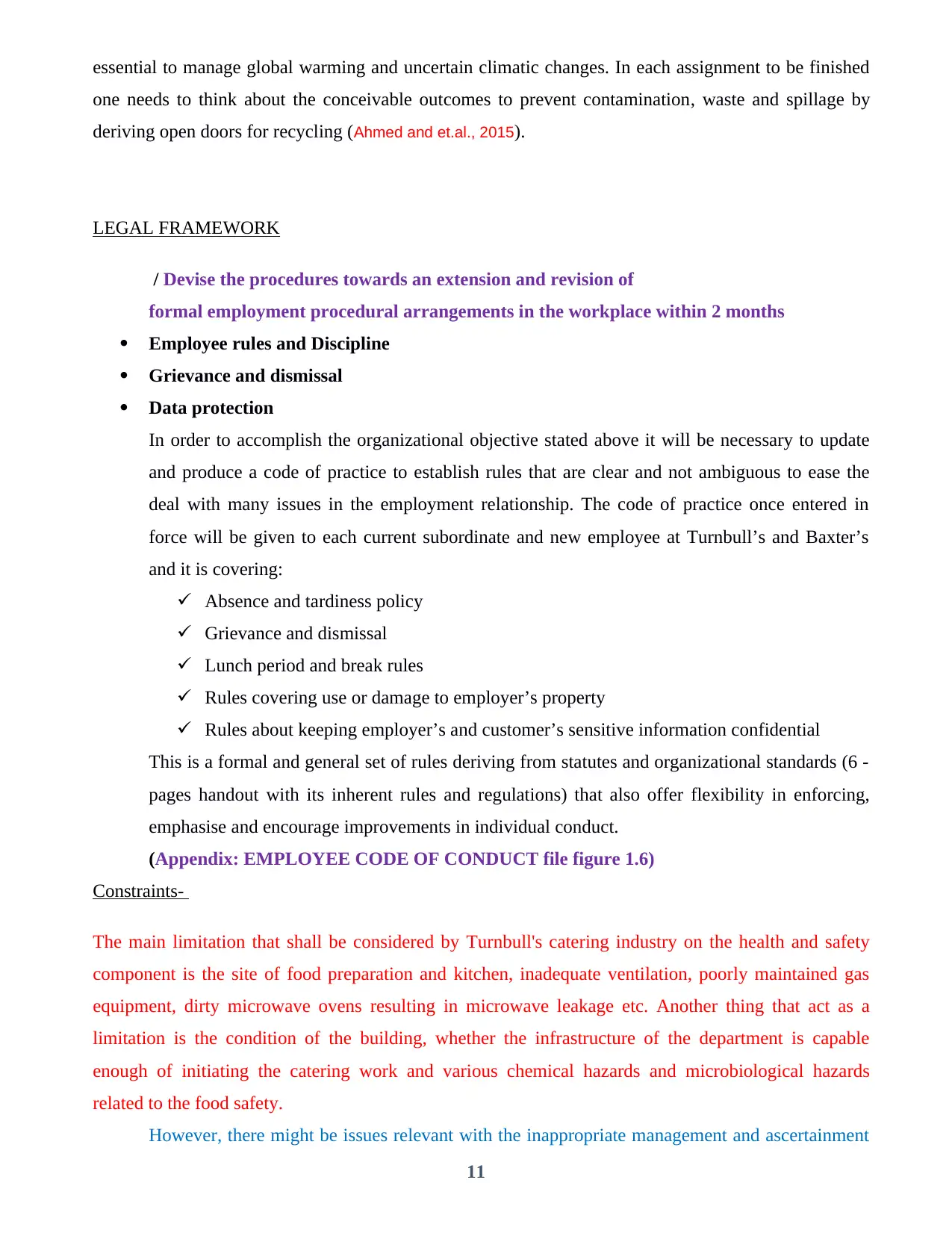
essential to manage global warming and uncertain climatic changes. In each assignment to be finished
one needs to think about the conceivable outcomes to prevent contamination, waste and spillage by
deriving open doors for recycling (Ahmed and et.al., 2015).
LEGAL FRAMEWORK
/ Devise the procedures towards an extension and revision of
formal employment procedural arrangements in the workplace within 2 months
Employee rules and Discipline
Grievance and dismissal
Data protection
In order to accomplish the organizational objective stated above it will be necessary to update
and produce a code of practice to establish rules that are clear and not ambiguous to ease the
deal with many issues in the employment relationship. The code of practice once entered in
force will be given to each current subordinate and new employee at Turnbull’s and Baxter’s
and it is covering:
Absence and tardiness policy
Grievance and dismissal
Lunch period and break rules
Rules covering use or damage to employer’s property
Rules about keeping employer’s and customer’s sensitive information confidential
This is a formal and general set of rules deriving from statutes and organizational standards (6 -
pages handout with its inherent rules and regulations) that also offer flexibility in enforcing,
emphasise and encourage improvements in individual conduct.
(Appendix: EMPLOYEE CODE OF CONDUCT file figure 1.6)
Constraints-
The main limitation that shall be considered by Turnbull's catering industry on the health and safety
component is the site of food preparation and kitchen, inadequate ventilation, poorly maintained gas
equipment, dirty microwave ovens resulting in microwave leakage etc. Another thing that act as a
limitation is the condition of the building, whether the infrastructure of the department is capable
enough of initiating the catering work and various chemical hazards and microbiological hazards
related to the food safety.
However, there might be issues relevant with the inappropriate management and ascertainment
11
one needs to think about the conceivable outcomes to prevent contamination, waste and spillage by
deriving open doors for recycling (Ahmed and et.al., 2015).
LEGAL FRAMEWORK
/ Devise the procedures towards an extension and revision of
formal employment procedural arrangements in the workplace within 2 months
Employee rules and Discipline
Grievance and dismissal
Data protection
In order to accomplish the organizational objective stated above it will be necessary to update
and produce a code of practice to establish rules that are clear and not ambiguous to ease the
deal with many issues in the employment relationship. The code of practice once entered in
force will be given to each current subordinate and new employee at Turnbull’s and Baxter’s
and it is covering:
Absence and tardiness policy
Grievance and dismissal
Lunch period and break rules
Rules covering use or damage to employer’s property
Rules about keeping employer’s and customer’s sensitive information confidential
This is a formal and general set of rules deriving from statutes and organizational standards (6 -
pages handout with its inherent rules and regulations) that also offer flexibility in enforcing,
emphasise and encourage improvements in individual conduct.
(Appendix: EMPLOYEE CODE OF CONDUCT file figure 1.6)
Constraints-
The main limitation that shall be considered by Turnbull's catering industry on the health and safety
component is the site of food preparation and kitchen, inadequate ventilation, poorly maintained gas
equipment, dirty microwave ovens resulting in microwave leakage etc. Another thing that act as a
limitation is the condition of the building, whether the infrastructure of the department is capable
enough of initiating the catering work and various chemical hazards and microbiological hazards
related to the food safety.
However, there might be issues relevant with the inappropriate management and ascertainment
11
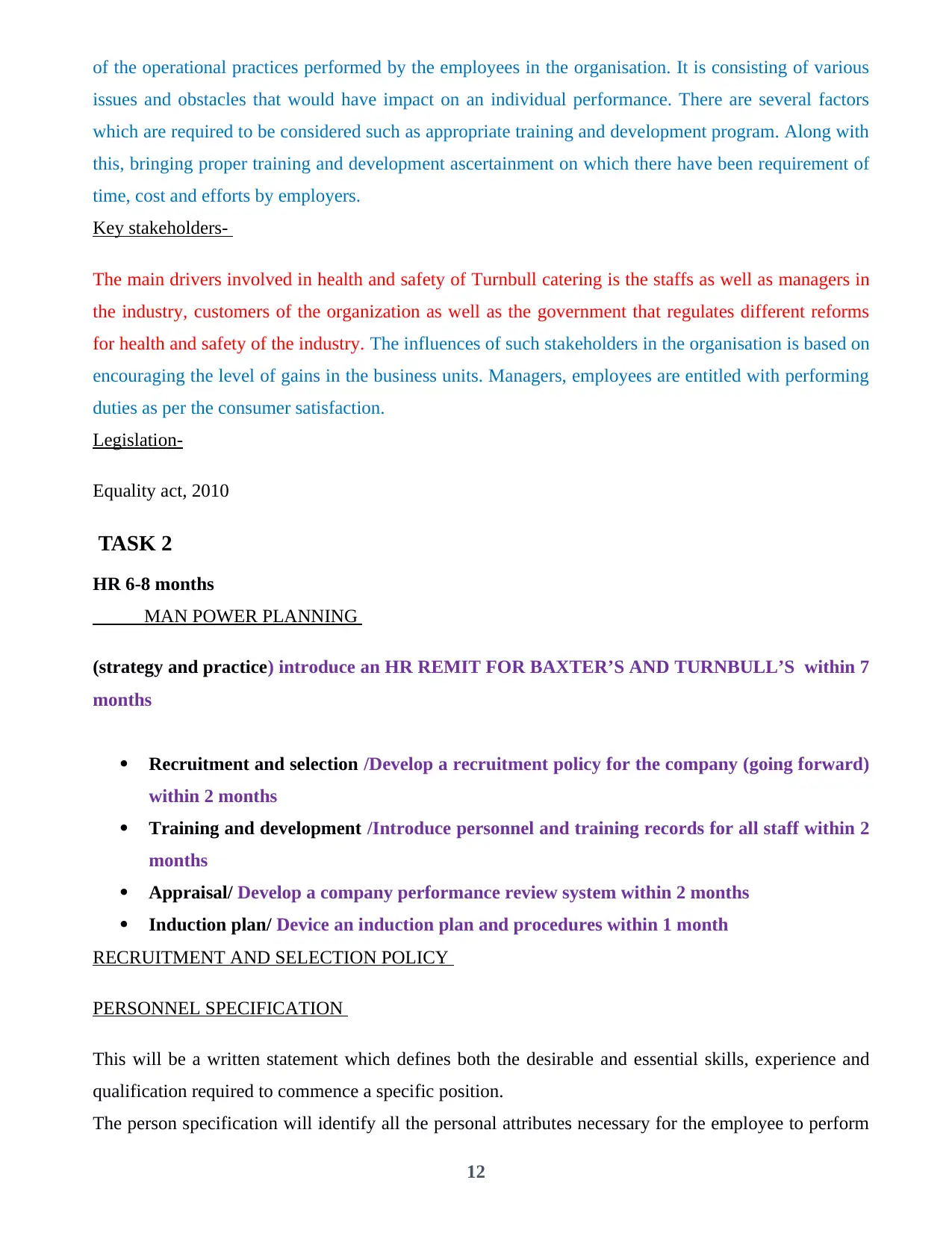
of the operational practices performed by the employees in the organisation. It is consisting of various
issues and obstacles that would have impact on an individual performance. There are several factors
which are required to be considered such as appropriate training and development program. Along with
this, bringing proper training and development ascertainment on which there have been requirement of
time, cost and efforts by employers.
Key stakeholders-
The main drivers involved in health and safety of Turnbull catering is the staffs as well as managers in
the industry, customers of the organization as well as the government that regulates different reforms
for health and safety of the industry. The influences of such stakeholders in the organisation is based on
encouraging the level of gains in the business units. Managers, employees are entitled with performing
duties as per the consumer satisfaction.
Legislation-
Equality act, 2010
TASK 2
HR 6-8 months
MAN POWER PLANNING
(strategy and practice) introduce an HR REMIT FOR BAXTER’S AND TURNBULL’S within 7
months
Recruitment and selection /Develop a recruitment policy for the company (going forward)
within 2 months
Training and development /Introduce personnel and training records for all staff within 2
months
Appraisal/ Develop a company performance review system within 2 months
Induction plan/ Device an induction plan and procedures within 1 month
RECRUITMENT AND SELECTION POLICY
PERSONNEL SPECIFICATION
This will be a written statement which defines both the desirable and essential skills, experience and
qualification required to commence a specific position.
The person specification will identify all the personal attributes necessary for the employee to perform
12
issues and obstacles that would have impact on an individual performance. There are several factors
which are required to be considered such as appropriate training and development program. Along with
this, bringing proper training and development ascertainment on which there have been requirement of
time, cost and efforts by employers.
Key stakeholders-
The main drivers involved in health and safety of Turnbull catering is the staffs as well as managers in
the industry, customers of the organization as well as the government that regulates different reforms
for health and safety of the industry. The influences of such stakeholders in the organisation is based on
encouraging the level of gains in the business units. Managers, employees are entitled with performing
duties as per the consumer satisfaction.
Legislation-
Equality act, 2010
TASK 2
HR 6-8 months
MAN POWER PLANNING
(strategy and practice) introduce an HR REMIT FOR BAXTER’S AND TURNBULL’S within 7
months
Recruitment and selection /Develop a recruitment policy for the company (going forward)
within 2 months
Training and development /Introduce personnel and training records for all staff within 2
months
Appraisal/ Develop a company performance review system within 2 months
Induction plan/ Device an induction plan and procedures within 1 month
RECRUITMENT AND SELECTION POLICY
PERSONNEL SPECIFICATION
This will be a written statement which defines both the desirable and essential skills, experience and
qualification required to commence a specific position.
The person specification will identify all the personal attributes necessary for the employee to perform
12
⊘ This is a preview!⊘
Do you want full access?
Subscribe today to unlock all pages.

Trusted by 1+ million students worldwide
1 out of 80
Related Documents
Your All-in-One AI-Powered Toolkit for Academic Success.
+13062052269
info@desklib.com
Available 24*7 on WhatsApp / Email
![[object Object]](/_next/static/media/star-bottom.7253800d.svg)
Unlock your academic potential
Copyright © 2020–2025 A2Z Services. All Rights Reserved. Developed and managed by ZUCOL.


